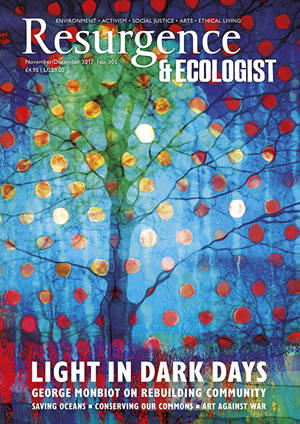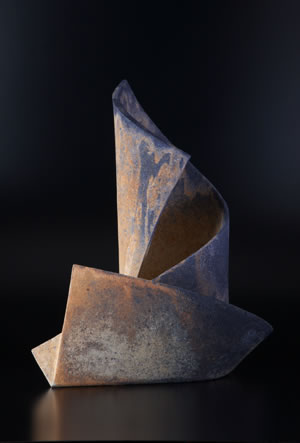A humble tea bowl sits poised, pedestalled in a glass cabinet. Light brushes its rough surface and catches the glaze dripping down from its rim. It exudes an aura of unassuming beauty, and of feeling immensely felt. Existing unto itself. Whole.
This particular black tea bowl by Raku Sanyū VI (1685–1739) is entitled Un’en kagan, meaning ‘Clouds and Haze Pass Before Your Eyes’. Peering through the glass in the Raku Museum in Kyoto, you can imagine the steam passing before your eyes against the obsidian glaze as you sip green tea from its depths.
Although ceramics is an incredibly varied field amongst Japan’s venerated craft traditions, a recent encounter with two of the country’s leading ceramic artists, Miwa Kazuhiko and Ken Mihara, revealed some of the remarkable historical and spiritual impulses that move them to create such compelling and contemporary work. Both Miwa and Mihara demonstrate an innate relationship with their materials and the natural processes that mould their work in the elemental coalescence of earth and fire.
After an eight-hour drive from Kyoto, we arrived in Hagi. Located in the Yamaguchi Prefecture on the western edge of the main island of Honshu, the town is home to Miwa Kazuhiko and his family’s legacy. Kazuhiko is the son of the late Miwa Kyusetsu XI, a national treasure and 11th generation of one of the most important potting dynasties in all of Japan, second only to Raku. The family’s distinguished teaware is high-fired stoneware with a thick, cloudy white glaze, which has been made in the Miwa kiln since it was established in 1663, and is still in use today.
We visited the Hagi Uragami Museum, where an impressive installation by Kazuhiko is exhibited alongside the work of his brother, father and great-grandfathers. Mysterious and large-scale ceramic slabs in gold, black, white and grey glazes are scattered throughout the gallery, uneven and angular, some broken and pieced back together, others left as ruins. We were soon met by Kazuhiko, who began to explain how his family’s tradition influenced his bold, sculptural work. He described how, as with much in life, each work is rooted on the ground and grows up towards the sky, to infinity or the future, and that much of his inspiration derives from big patterns in Nature, such as the Grand Canyon and Yosemite: inspired by the earth and made up of the earth.
Kazuhiko showed us to his traditional wooden house and extensive studio complex on the outskirts of Hagi. There was the five-chambered, hand-built, wood-fired climbing kiln built into a slope – a method introduced from Korea. Kazuhiko explained how the kiln is first purified with salt before it is lit, and can take over 30 hours to fire a single load. He mixes different raw clays with coarse sand, which is not very malleable, so his ceramics often crack or fall apart completely. “It’s delicate work,” he says. “One out of dozens is successful.”
The differing materials, their irons and minerals, react differently to temperature, so the artist cannot completely control how the object turns out. A work begins relatively even at the start, and the magic happens in the kiln. With a synergetic effect, the lustrous white glaze beads up to reveal the textured reddish-black clay underneath. The making of each work becomes a dialogue between the artist’s vision and the nature of his materials. Each descendant adapts these age-old techniques for his own trademark flare of originality, including the recipe for the semi-opaque glaze made from the straw ash of burnt rice plants grown in nearby fields.
A treasured Oni-Hagi tea bowl with its uneven and potted white glaze sits on a spot-lit shelf in Kazuhiko’s private gallery. What is it that makes this work successful? Kazuhiko explains how it is all about feeling: a work just feels right. It is exactly as it is meant to be. It goes beyond the idea of aesthetic arrangement to reveal an implicit balance of Nature and imperfection, melded to create something so perfectly pleasing.
An object as an embodiment of life – the coexisting imperfections and perfections of human and Nature – epitomises the Japanese aesthetic concept of wabi-sabi, based on the acceptance of transience and imperfection. Derived from the Buddhist teaching of the three marks of existence – impermanence, suffering and absence of self – it adheres to beauty that is imperfect, impermanent and incomplete, as in the key aspects of the tea ceremony purported by master Sen no Rikyū (1522–91): rustic simplicity, directness of approach, and honesty of self. As well as observing the aesthetics of imperfection, wabi-sabi beholds the intimacy and appreciation of the ingenuous integrity of natural objects and processes.
The next day we drove up the coast to Izumo, home to the oldest shrine in Japan and an ancient archaeological site with tumuli dating back to the 6th century. Set within the surrounding smoking mountains is the home and studio of Ken Mihara, whose primal and talismanic forms conjure up the ceremonial ambience of ancient bronzeware whilst echoing the environs of Izumo.
A work spirals up from the wheel-head and flutes upward into the air in Mihara’s studio. Mihara describes how he moved away from functional, vessel-like forms towards pure self-expression, his works becoming objects in their own right. “My heart has been set free,” he writes. “What has been ingrained in the body and the many rules of consciousness are no longer needed. My expressions have embraced, and are honest towards, what is borne within.”
Mihara’s works are realised through the intricate and intimate technique of hand-coiling – allowing for the artist to instil and transpose himself within the work. He does not sketch or begin with a form in mind, but rather allows his hands to “begin a conversation with the clay”. With an aura of serenity and Zen-like simplicity, the presence of the artist is tangible in Mihara’s works, which, in his words, “embody the never-ending pursuit of unforeseen beauty”.
Mihara explains how each work undergoes multiple firings, during which a myriad of colours emerge across the surface of this local iron-rich clay. Without any glazes, decorative details or finishes, the clay’s inherent minerals react with fire and oxygen to manifest landscapes of vivid purples, indigos, oranges and yellows across its raw, textured surface. Mihara speaks of the clay found beneath our feet as having a distinct memory of colours trapped within it, and the way in which it is fired can “unlock the memories within clay”. Although Mihara cannot predict what the colours will be, he can intuitively adjust the oxygen and temperature levels that give rise to a wider spectrum of colour.
Within the symbiosis of man’s creative impulse and natural forces in the work of these ceramic artists, there’s a natural resonance that is so intrinsic that it is unquestionable. Echoing Japan’s Shinto tradition, in which all things natural, even those inanimate, are worshipped as divine, rejecting the idea of the human mind being at the centre of existence, this reverence for Nature can be seen as recognition of the power of all matter and materials. Nature is as much an author of the work as they are.







